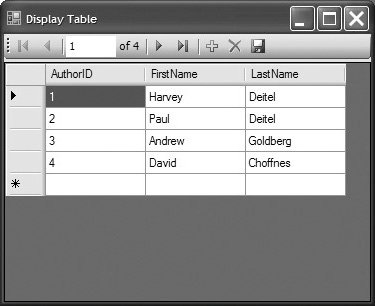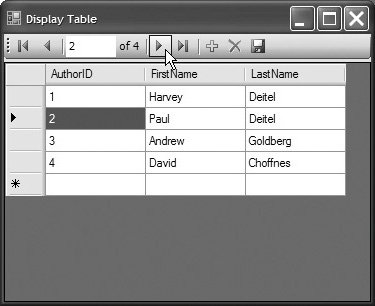Programming with ADO.NET: Extracting Information from a Database
Programming with ADO NET Extracting Information from a Database
In this section, we demonstrate how to connect to a database, query the database and display the result of the query. You will notice that there is little code in this section. The IDE provides visual programming tools and wizards that simplify accessing data in your projects. These tools establish database connections and create the ADO.NET objects necessary to view and manipulate the data through GUI controls. The example in this section connects to the SQL Server Books database that we have discussed throughout this chapter. The Books.mdf file that contains the database can be found with the chapter's examples (www.deitel.com/books/csharpforprogrammers2).
20.6.1. Displaying a Database Table in a DataGridView
This example performs a simple query on the Books database that retrieves the entire Authors table and displays the data in a DataGridView (a control from namespace System.Windows.Forms that can display a data source in a GUIsee the output in Fig. 20.32 later in this section). First, we demonstrate how to connect to the Books database and include it as a data source in your project. Once the Books database is established as a data source, you can display the data from the Authors table in a DataGridView simply by dragging and dropping items in the project's Design view.
Step 1: Creating the Project
Create a new Windows Application named DisplayTable. Change the Form name to DisplayTableForm and change the source file name to DisplayTable.cs. Then set the Form's Text property to Display Table.
Step 2: Adding a Data Source to the Project
To interact with a data source (e.g., a database), you must add it to the project using the Data Sources window, which lists the data that your project can access. Open the Data Sources window (Fig. 20.23) by selecting Data > Show Data Sources or by clicking the tab to the right of the tab for the Solution Explorer. In the Data Sources window, click Add New Data Source... to open the Data Source Configuration Wizard (Fig. 20.24). This wizard guides you through connecting to a database and choosing the parts of the database you will want to access in your project.
Figure 20.23. Adding a data source to a project.

Figure 20.24. Choosing the data source type in the Data Source Configuration Wizard.
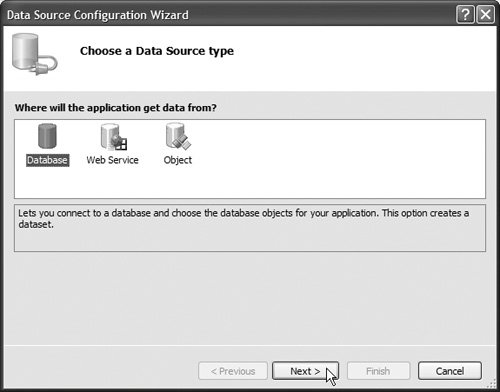
Step 3: Choosing the Data Source Type to Add to the Project
The first screen of the Data Source Configuration Wizard (Fig. 20.24) asks you to choose the data source type you wish to include in the project. Select Database and click Next >.
Step 4: Adding a New Database Connection
You must next choose the connection that will be used to connect to the database (i.e., the actual source of the data). Click New Connection... to open the Add Connection dialog (Fig. 20.25). If the Data Source is not set to Microsoft SQL Server Database File (SqlClient), click Change..., select Microsoft SQL Server Database File and click OK. In the Add Connection dialog, click Browse..., locate the Books.mdf database file on your computer, select it and click Open. You can click Test Connection to verify that the IDE can connect to the database through SQL Server. Click OK to create the connection.
Figure 20.25. Adding a new data connection.
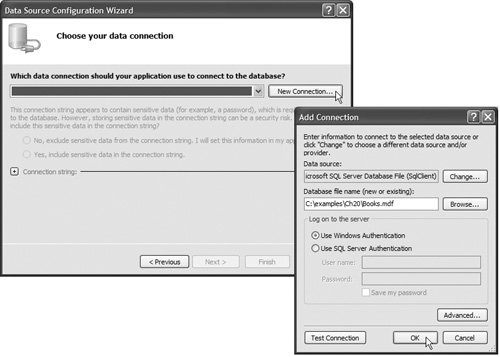
Step 5: Choosing the Books.mdf Data Connection
Now that you have created a connection to the Books.mdf database, you can select and use this connection to access the database. Click Next > to set the connection, then click Yes when asked whether you want to move the database file to your project (Fig. 20.26).
Figure 20.26. Choosing the Books.mdf data connection.
(This item is displayed on page 1013 in the print version)

Step 6: Saving the Connection String
The next screen (Fig. 20.27) asks you whether you want to save the connection string to the application configuration file. A connection string specifies the path to a database file on disk, as well as some additional settings that determine how to access the database. Saving the connection string in a configuration file makes it easy to change the connection settings at a later time. Leave the default selections and click Next > to proceed.
Figure 20.27. Saving the connection string to the application configuration file.
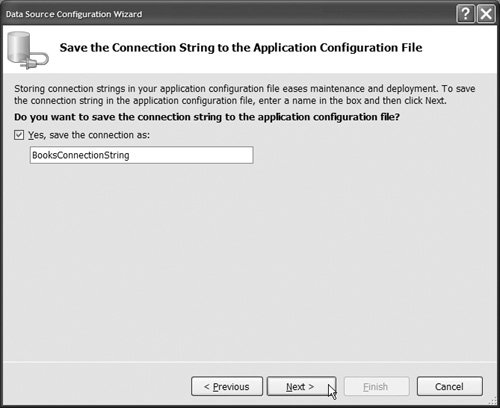
Step 7: Selecting the Database Objects to Include in Your DataSet
The IDE retrieves information about the database you selected and prompts you to select the database objects (i.e., the parts of the database) that you want your project to be able to access (Fig. 20.28). Recall that programs typically access a database's contents through a cache of the data, which is stored in a DataSet. In response to your selections in this screen, the IDE will generate a class derived from System.Data.DataSet that is designed specifically to store data from the Books database. Click the checkbox to the left of Tables to indicate that the custom DataSet should cache (i.e., locally store) the data from all the tables in the Books databaseAuthors, AuthorISBN and Titles. [Note: You can also expand the Tables node to select specific tables. The other database objects listed do not contain any data in our sample Books database and are beyond the scope of the book.] By default, the IDE names the DataSet BooksDataSet, though it is possible to specify a different name in this screen. Finally, click Finish to complete the process of adding a data source to the project.
Figure 20.28. Choosing the database objects to include in the DataSet.

Step 8: Viewing the Data Source in the Data Sources Window
Notice that a BooksDataSet node now appears in the Data Sources window (Fig. 20.29) with child nodes for each table in the Books databasethese nodes represent the DataTables of the BooksDataSet. Expand the Authors node and you will see the table's columnsthe DataSet's structure mimics that of the actual Books database.
Figure 20.29. Viewing a data source listed in the Data Sources window.
(This item is displayed on page 1015 in the print version)
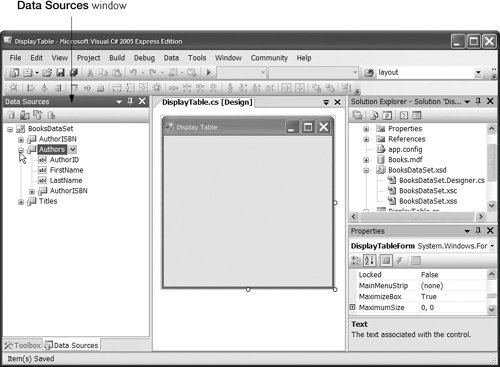
Step 9: Viewing the Database in the Solution Explorer
Books.mdf is now listed as a node in the Solution Explorer (Fig. 20.30), indicating that the database is now part of this project. In addition, the Solution Explorer now lists a new node named BooksDataSet.xsd. You learned in Chapter 19 that a file with the .xsd extension is an XML Schema document, which specifies the structure of a set of XML documents. The IDE uses an XML Schema document to represent a DataSet's structure, including the tables that comprise the DataSet and the relationships among them. When you added the Books database as a data source, the IDE created the BooksDataSet.xsd file based on the structure of the Books database. The IDE then generated class BooksDataSet from the schema (i.e., structure) described by the .xsd file.
Figure 20.30. Viewing a database listed in the Solution Explorer.
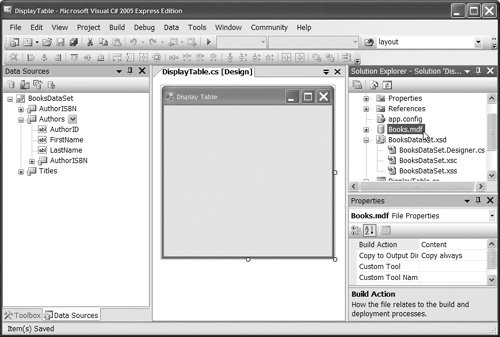
Displaying the Authors Table
Now that you have added the Books database as a data source, you can display the data from the database's Authors table in your program. The IDE provides design tools that allow you to display data from a data source on a Form without writing any code. Simply drag and drop items from the Data Sources window onto a Form, and the IDE generates the GUI controls and code necessary to display the selected data source's content.
To display the Authors table of the Books database, drag the Authors node from the Data Sources window to the Form. Figure 20.31 presents the Design view after we performed this action and resized the controls. The IDE generates two GUI controls that appear on DisplayTableFormauthorsBindingNavigator and authorsDataGridView. The IDE also generates several additional non-visual components that appear in the component traythe gray region below the Form in Design view. We use the IDE's default names for these autogenerated components (and others throughout the chapter) to show exactly what the IDE creates. We briefly discuss the authorsBindingNavigator and authorsDataGridView controls here. The next section discusses all of the autogenerated components in detail and explains how the IDE uses these components to connect the GUI controls to the Authors table of the Books database.
Figure 20.31. Design view after dragging the Authors data source node to the Form.

A DataGridView displays data organized in rows and columns that correspond to the rows and columns of the underlying data source. In this case, the DataGridView displays the data of the Authors table, so the control has columns named AuthorID, FirstName and LastName. In Design view, the control does not display any rows of actual data below the column headers. The data is retrieved from the database and displayed in the DataGridView only at runtime. Execute the program. When the Form loads, the DataGridView contains four rows of dataone for each row of the Authors table (Fig. 20.32).
Figure 20.32. Displaying the Authors table in a DataGridView.
(a)
(b)

The strip of buttons below the title bar of the window is a BindingNavigator, which enables users to browse and manipulate data displayed by another GUI control (in this case, a DataGridView) on the Form. A BindingNavigator's buttons resemble the controls on a CD or DVD player and allow you to move to the first row of data, the preceding row, the next row and the last row. The control also displays the currently selected row number in a text box. You can use this text box to enter the number of a row that you want to select. The authorsBindingNavigator in this example allows you to "navigate" the Authors table displayed in the authorsDataGridView. Clicking the buttons or entering a value in the text box causes the DataGridView to select the appropriate row. An arrow in the DataGridView's leftmost column indicates the currently selected row.
A BindingNavigator also has buttons that allow you to add a new row, delete a row and save changes back to the underlying data source (in this case, the Authors table of the Books database). Clicking the button with the yellow plus icon ( ) adds a new row to the DataGridView. However, simply typing values in the FirstName and LastName columns does not insert a new row in the Authors table. To add the new row to the database on disk, click the Save button (the button with the disk icon,
) adds a new row to the DataGridView. However, simply typing values in the FirstName and LastName columns does not insert a new row in the Authors table. To add the new row to the database on disk, click the Save button (the button with the disk icon,  ). Clicking the button with the red X (
). Clicking the button with the red X ( ) deletes the currently selected row from the DataGridView. Again, you must click the Save button to make the change in the database. Test these buttons. Execute the program and add a new row, then save the changes and close the program. When you restart the program, you should see that the new row was saved to the database and appears in the DataGridView. Now delete the new row and click the Save button. Close and restart the program to see that the new row no longer exists in the database.
) deletes the currently selected row from the DataGridView. Again, you must click the Save button to make the change in the database. Test these buttons. Execute the program and add a new row, then save the changes and close the program. When you restart the program, you should see that the new row was saved to the database and appears in the DataGridView. Now delete the new row and click the Save button. Close and restart the program to see that the new row no longer exists in the database.
20.6.2. How Data Binding Works
The technique through which GUI controls are connected to data sources is known as data binding. The IDE allows controls, such as a DataGridView, to be bound to a data source, such as a DataSet that represents a table in a database. Any changes you make through the application to the underlying data source will automatically be reflected in the way the data is presented in the data-bound control (e.g., the DataGridView). Likewise, modifying the data in the data-bound control and saving the changes updates the underlying data source. In the current example, the DataGridView is bound to the DataTable of the BooksDataSet that represents the Authors table in the database. Dragging the Authors node from the Data Sources window to the Form caused the IDE to create this data binding for you, using several autogenerated components (i.e., objects) in the component tray. Figure 20.33 models these objects and their associations, which the following sections examine in detail to explain how data binding works.
Figure 20.33. Data binding architecture used to display the Authors table of the Books database in a GUI.
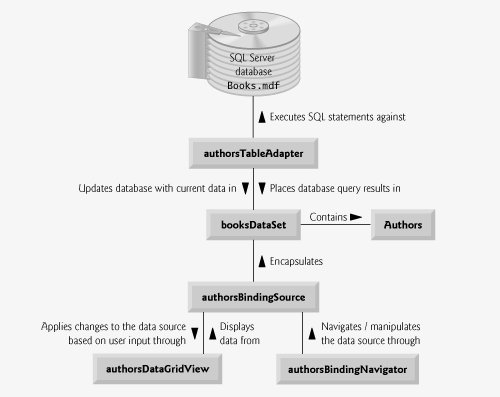
BooksDataSet
As discussed in Section 20.6.1, adding the Books database to the project enabled the IDE to generate the BooksDataSet. Recall that a DataSet represents a cache of data that mimics the structure of a relational database. You can explore the structure of the BooksDataSet in the Data Sources window. A DataSet's structure can be determined at execution time or at design time. An untyped DataSet's structure (i.e., the tables that comprise it and the relationships among them) is determined at execution time based on the result of a specific query. Tables and column values are accessed using indices into collections of DataTables and DataRows, respectively. The type of each piece of data in an untyped DataSet is unknown at design time. BooksDataSet, however, is created by the IDE at design time as a strongly typed DataSet. BooksDataSet (a derived class of DataSet) contains objects of classes derived from DataTable that represent the tables in the Books database. BooksDataSet provides properties corresponding to the objects whose names match those of the underlying tables. For example, booksDataSet.Authors represents a cache of the data in the Authors table. Each DataTable contains a collection of DataRows. Each DataRow contains members whose names and types correspond to those of the columns of the underlying database table. Thus, booksDataSet.Authors[ 0 ].AuthorID refers to the AuthorID of the first row of the Authors table in the Books database. Note that zero-based indices are used to access DataRows in a DataTable.
The booksDataSet object in the component tray is an object of the BooksDataSet class. When you indicate that you want to display the contents of the Authors table on the Form, the IDE generates a BooksDataSet object to store the data that Form will display. This is the data to which the DataGridView will be bound. The DataGridView does not display data from the database directly. Instead, it displays the contents of a BooksDataSet object. As we discuss shortly, the AuthorsTableAdapter fills the BooksDataSet object with data retrieved from the database by executing a SQL query.
AuthorsTableAdapter
The AuthorsTableAdapter is the component that interacts with the Books database on disk (i.e., the Books.mdf file). When other components need to retrieve data from the database or write data to the database, they invoke the methods of the AuthorsTableAdapter. Class AuthorsTableAdapter is generated by the IDE when you drag a table from the Books database onto the Form. The authorsTableAdapter object in the component tray is an object of this class. The AuthorsTableAdapter is responsible for filling the BooksDataSet with the Authors data from the databasethis stores a copy of the Authors table in local memory. As you will soon see, this cached copy can be modified during program execution. Thus, the AuthorsTableAdapter is also responsible for updating the database when the data in the BooksDataSet changes.
Class AuthorsTableAdapter encapsulates a SqlDataAdapter object, which contains SqlCommand objects that specify how the SqlDataAdapter selects, inserts, updates and deletes data in the database. Recall from Section 20.5 that a SqlCommand object must have a SqlConnection object through which the SqlCommand can communicate with a database. In this example, the AuthorsTableAdapter sets the Connection property of each of the SqlDataAdapter's SqlCommand objects, based on the connection string that refers to the Books database.
To interact with the database, the AuthorsTableAdapter invokes the methods of its SqlDataAdapter, each of which executes the appropriate SqlCommand object. For example, to fill the BooksDataSet's Authors table, the AuthorsTableAdapter's Fill method invokes its SqlDataAdapter's Fill method, which executes a SqlCommand object representing the SELECT query
SELECT AuthorID, FirstName, LastName FROM Authors
This query selects all the rows and columns of the Authors table and places them in booksDataSet.Authors. You will see an example of authorsTableAdapter's Fill method being invoked shortly.
authorsBindingSource and authorsDataGridView
The authorsBindingSource object (an object of class BindingSource) identifies a data source that a program can bind to a control and serves as an intermediary between a databound GUI control and its data source. In this example, the IDE uses a BindingSource object to connect the authorsDataGridView to booksDataSet.Authors. To achieve this data binding, the IDE first sets authorsBindingSource's DataSource property to BooksDataSet. This property specifies the DataSet that contains the data to be bound. The IDE then sets the DataMember property to Authors. This property identifies a specific table within the DataSource. After configuring the authorsBindingSource object, the IDE assigns this object to authorsDataGridView's DataSource property to indicate what the DataGridView will display.
A BindingSource object also manages the interaction between a data-bound GUI control and its underlying data source. If you edit the data displayed in a DataGridView and want to save changes to the data source, your code must invoke the EndEdit method of the BindingSource object. This method applies the changes made to the data through the GUI control (i.e., the pending changes) to the data source bound to that control. Note that this updates only the DataSetan additional step is required to permanently update the database itself. You will see an example of this shortly, when we present the code generated by the IDE in the DisplayTable.cs file.
authorsBindingNavigator
Recall that a BindingNavigator allows you to move through (i.e., navigate) and manipulate (i.e., add or delete rows) data bound to a control on a Form. A BindingNavigator communicates with a BindingSource (specified in the BindingNavigator's BindingSource property) to carry out these actions in the underlying data source (i.e., the DataSet). The BindingNavigator does not interact with the data-bound control. Instead, it invokes BindingSource methods that cause the data-bound control to update its presentation of the data. For example, when you click the BindingNavigator's button to add a new row, the BindingNavigator invokes a method of the BindingSource. The BindingSource then adds a new row to its associated DataSet. Once this DataSet is modified, the DataGridView displays the new row, because the DataGridView and the BindingNavigator are bound to the same BindingSource object (and thus the same DataSet).
Examining the Autogenerated Code for DisplayTableForm
Figure 20.34 presents the code for DisplayTableForm. Note that you do not need to write any of this codethe IDE generates it when you drag and drop the Authors table from the Data Sources window onto the Form. We modified the autogenerated code to add comments, split long lines for display purposes and remove unnecessary using declarations. The IDE also generates a considerable amount of additional code, such as the code that defines classes BooksDataSet and AuthorsTableAdapter, as well as the designer code that declares the autogenerated objects in the component tray. The additional IDE-generated code resides in files visible in the Solution Explorer when you select Show All Files. We present only the code in DisplayTable.cs, because it is the only file you'll need to modify.
Figure 20.34. Auto-generated code for displaying data from a database table in a DataGridView control.
(This item is displayed on page 1021 in the print version)
1 // Fig. 20.34: DisplayTable.cs
2 // Displays data from a database table in a DataGridView.
3 using System;
4 using System.Windows.Forms;
5
6 namespace DisplayTable
7 {
8 public partial class DisplayTableForm : Form
9 {
10 public DisplayTableForm()
11 {
12 InitializeComponent();
13 } // end constructor
14
15 // Click event handler for the Save Button in the
16 // BindingNavigator saves the changes made to the data
17 private void authorsBindingNavigatorSaveItem_Click(
18 object sender, EventArgs e )
19 {
20 this.Validate();
21 this.authorsBindingSource.EndEdit();
22 this.authorsTableAdapter.Update( this.booksDataSet.Authors );
23 } // end method authorsBindingNavigatorSaveItem_Click
24
25 // loads data into the booksDataSet.Authors table,
26 // which is then displayed in the DataGridView
27 private void DisplayTableForm_Load( object sender, EventArgs e )
28 {
29 // TODO: This line of code loads data into the
30 // 'booksDataSet.Authors' table. You can move, or remove it,
31 // as needed.
32 this.authorsTableAdapter.Fill( this.booksDataSet.Authors );
33 } // end method DisplayTableForm_Load
34 } // end class DisplayTableForm
35 } // end namespace DisplayTable
(a)
(b)
|
Lines 1723 contain the Click event handler for the Save button in the AuthorsBindingNavigator. Recall that you click this button to save changes made to the data in the DataGridView in the underlying data source (i.e., the Authors table of the Books database). Saving the changes is a two-step process:
|
1. |
The DataSet associated with the DataGridView (indicated by its BindingSource) must be updated to include any changes made by the user. |
|
2. |
The database on disk must be updated to match the new contents of the DataSet. |
Before the event handler saves any changes, line 21 invokes this.Validate() to validate the controls on the Form. If you implement Validating or Validated events for any of Form's controls, these events enable you to validate user input and potentially indicate errors for invalid data. Line 21 invokes authorsBindingSource's EndEdit method to ensure that the object's associated data source (booksDataSet.Authors) is updated with any changes made by the user to the currently selected row in the DataGridView (e.g., adding a row, changing a column value). Any changes to other rows were applied to the DataSet when you selected another row. Line 22 invokes authorsTableAdapter's Update method to write the modified version of the Authors table (in memory) to the SQL Server database on disk. The Update method executes the SQL statements (encapsulated in SqlCommand objects) necessary to make the database's Authors table match booksDataSet.Authors.
The Load event handler for DisplayTableForm (lines 2733) executes when the program loads. This event handler fills the in-memory DataSet with data from the SQL Server database on disk. Once the DataSet is filled, the GUI control bound to it can display its data. Line 32 calls authorsTableAdapter's Fill method to retrieve information from the database, placing this information in the DataSet member provided as an argument. Recall that authorsTableAdapter was generated by the IDE to execute SqlCommands over the connection we created within the Data Source Configuration Wizard. Thus, the Fill method here executes a SELECT statement to retrieve all the rows of the Authors table of the Books database, then places the result of this query in booksDataSet.Authors. Recall that authorsDataGridView's DataSource property is set to authorsBindingSource (which references booksDataSet.Authors). Thus, after this data source is loaded, the authorsDataGridView automatically displays the data retrieved from the database.
Preface
Index
Introduction to Computers, the Internet and Visual C#
- Introduction
- What Is a Computer?
- Computer Organization
- Early Operating Systems
- Personal Computing, Distributed Computing and Client/Server Computing
- Hardware Trends
- Microsofts Windows® Operating System
- Machine Languages, Assembly Languages and High-Level Languages
- C#
- C, C++, Java and Visual Basic
- Other High-Level Languages
- The Internet and the World Wide Web
- Extensible Markup Language (XML)
- Microsofts .NET
- The .NET Framework and the Common Language Runtime
- Test-Driving a C# Application
- Software Engineering Case Study: Introduction to Object Technology and the UML
- Wrap-Up
- Web Resources
- Summary
- Terminology
- Self-Review Exercises
- Exercises
Introduction to the Visual C# 2005 Express Edition IDE
- Introduction
- Overview of the Visual Studio 2005 IDE
- Menu Bar and Toolbar
- Navigating the Visual Studio 2005 IDE
- Using Help
- Using Visual Programming to Create a Simple Program Displaying Text and an Image
- Wrap-Up
- Web Resources
- Summary
- Terminology
- Self-Review Exercises
- Exercises
Introduction to C# Applications
- Introduction
- A Simple C# Application: Displaying a Line of Text
- Creating Your Simple Application in Visual C# Express
- Modifying Your Simple C# Application
- Formatting Text with Console.Write and Console.WriteLine
- Another C# Application: Adding Integers
- Memory Concepts
- Arithmetic
- Decision Making: Equality and Relational Operators
- (Optional) Software Engineering Case Study: Examining the ATM Requirements Document
- Wrap-Up
- Summary
- Terminology
- Self-Review Exercises
- Exercises
Introduction to Classes and Objects
- Introduction
- Classes, Objects, Methods, Properties and Instance Variables
- Declaring a Class with a Method and Instantiating an Object of a Class
- Declaring a Method with a Parameter
- Instance Variables and Properties
- UML Class Diagram with a Property
- Software Engineering with Properties and set and get Accessors
- Value Types vs. Reference Types
- Initializing Objects with Constructors
- Floating-Point Numbers and Type decimal
- (Optional) Software Engineering Case Study: Identifying the Classes in the ATM Requirements Document
- Wrap-Up
- Summary
- Terminology
- Self-Review Exercises
- Exercises
Control Statements: Part 1
- Introduction
- Algorithms
- Pseudocode
- Control Structures
- if Single-Selection Statement
- if...else Double-Selection Statement
- while Repetition Statement
- Formulating Algorithms: Counter-Controlled Repetition
- Formulating Algorithms: Sentinel-Controlled Repetition
- Formulating Algorithms: Nested Control Statements
- Compound Assignment Operators
- Increment and Decrement Operators
- Simple Types
- (Optional) Software Engineering Case Study: Identifying Class Attributes in the ATM System
- Wrap-Up
- Summary
- Terminology
- Self-Review Exercises
- Exercises
Control Statements: Part 2
- Introduction
- Essentials of Counter-Controlled Repetition
- for Repetition Statement
- Examples Using the for Statement
- do...while Repetition Statement
- switch Multiple-Selection Statement
- break and continue Statements
- Logical Operators
- Structured Programming Summary
- (Optional) Software Engineering Case Study: Identifying Objects States and Activities in the ATM System
- Wrap-Up
- Summary
- Terminology
- Self-Review Exercises
- Exercises
Methods: A Deeper Look
- Introduction
- Packaging Code in C#
- static Methods, static Variables and Class Math
- Declaring Methods with Multiple Parameters
- Notes on Declaring and Using Methods
- Method Call Stack and Activation Records
- Argument Promotion and Casting
- The Framework Class Library
- Case Study: Random-Number Generation
- Case Study: A Game of Chance (Introducing Enumerations)
- Scope of Declarations
- Method Overloading
- Recursion
- Passing Arguments: Pass-by-Value vs. Pass-by-Reference
- (Optional) Software Engineering Case Study: Identifying Class Operations in the ATM System
- Wrap-Up
- Summary
- Terminology
- Self-Review Exercises
- Exercises
Arrays
- Introduction
- Arrays
- Declaring and Creating Arrays
- Examples Using Arrays
- Case Study: Card Shuffling and Dealing Simulation
- foreach Statement
- Passing Arrays and Array Elements to Methods
- Passing Arrays by Value and by Reference
- Case Study: Class GradeBook Using an Array to Store Grades
- Multidimensional Arrays
- Case Study: Class GradeBook Using a Rectangular Array
- Variable-Length Argument Lists
- Using Command-Line Arguments
- (Optional) Software Engineering Case Study: Collaboration Among Objects in the ATM System
- Wrap-Up
- Summary
- Terminology
- Self-Review Exercises
- Exercises
- Special Section: Building Your Own Computer
Classes and Objects: A Deeper Look
- Introduction
- Time Class Case Study
- Controlling Access to Members
- Referring to the Current Objects Members with the this Reference
- Indexers
- Time Class Case Study: Overloaded Constructors
- Default and Parameterless Constructors
- Composition
- Garbage Collection and Destructors
- static Class Members
- readonly Instance Variables
- Software Reusability
- Data Abstraction and Encapsulation
- Time Class Case Study: Creating Class Libraries
- internal Access
- Class View and Object Browser
- (Optional) Software Engineering Case Study: Starting to Program the Classes of the ATM System
- Wrap-Up
- Summary
- Terminology
- Self-Review Exercises
- Exercises
Object-Oriented Programming: Inheritance
- Introduction
- Base Classes and Derived Classes
- protected Members
- Relationship between Base Classes and Derived Classes
- Constructors in Derived Classes
- Software Engineering with Inheritance
- Class object
- Wrap-Up
- Summary
- Terminology
- Self-Review Exercises
- Exercises
Polymorphism, Interfaces & Operator Overloading
- Introduction
- Polymorphism Examples
- Demonstrating Polymorphic Behavior
- Abstract Classes and Methods
- Case Study: Payroll System Using Polymorphism
- sealed Methods and Classes
- Case Study: Creating and Using Interfaces
- Operator Overloading
- (Optional) Software Engineering Case Study: Incorporating Inheritance and Polymorphism into the ATM System
- Wrap-Up
- Summary
- Terminology
- Self-Review Exercises
- Exercises
Exception Handling
- Introduction
- Exception Handling Overview
- Example: Divide by Zero Without Exception Handling
- Example: Handling DivideByZeroExceptions and FormatExceptions
- .NET Exception Hierarchy
- finally Block
- Exception Properties
- User-Defined Exception Classes
- Wrap-Up
- Summary
- Terminology
- Self-Review Exercises
- Exercises
Graphical User Interface Concepts: Part 1
- Introduction
- Windows Forms
- Event Handling
- Control Properties and Layout
- Labels, TextBoxes and Buttons
- GroupBoxes and Panels
- CheckBoxes and RadioButtons
- PictureBoxes
- ToolTips
- NumericUpDown Control
- Mouse-Event Handling
- Keyboard-Event Handling
- Wrap-Up
- Summary
- Terminology
- Self-Review Exercises
- Answers To Self-Review Exercises
- Exercises
Graphical User Interface Concepts: Part 2
- Introduction
- Menus
- MonthCalendar Control
- DateTimePicker Control
- LinkLabel Control
- ListBox Control
- CheckedListBox Control
- ComboBox Control
- TreeView Control
- ListView Control
- TabControl Control
- Multiple Document Interface (MDI) Windows
- Visual Inheritance
- User-Defined Controls
- Wrap-Up
- Summary
- Terminology
- Self-Review Exercises
- Exercises
Multithreading
- Introduction
- Thread States: Life Cycle of a Thread
- Thread Priorities and Thread Scheduling
- Creating and Executing Threads
- Thread Synchronization and Class Monitor
- Producer/Consumer Relationship without Thread Synchronization
- Producer/Consumer Relationship with Thread Synchronization
- Producer/Consumer Relationship: Circular Buffer
- Multithreading with GUIs
- Wrap-Up
- Summary
- Terminology
- Self-Review Exercises
- Exercises
Strings, Characters and Regular Expressions
- Introduction
- Fundamentals of Characters and Strings
- string Constructors
- string Indexer, Length Property and CopyTo Method
- Comparing strings
- Locating Characters and Substrings in strings
- Extracting Substrings from strings
- Concatenating strings
- Miscellaneous string Methods
- Class StringBuilder
- Length and Capacity Properties, EnsureCapacity Method and Indexer of Class StringBuilder
- Append and AppendFormat Methods of Class StringBuilder
- Insert, Remove and Replace Methods of Class StringBuilder
- Char Methods
- Card Shuffling and Dealing Simulation
- Regular Expressions and Class Regex
- Wrap-Up
- Summary
- Terminology
- Self-Review Exercises
- Exercises
Graphics and Multimedia
- Introduction
- Drawing Classes and the Coordinate System
- Graphics Contexts and Graphics Objects
- Color Control
- Font Control
- Drawing Lines, Rectangles and Ovals
- Drawing Arcs
- Drawing Polygons and Polylines
- Advanced Graphics Capabilities
- Introduction to Multimedia
- Loading, Displaying and Scaling Images
- Animating a Series of Images
- Windows Media Player
- Microsoft Agent
- Wrap-Up
- Summary
- Terminology
- Self-Review Exercises
- Exercises
Files and Streams
- Introduction
- Data Hierarchy
- Files and Streams
- Classes File and Directory
- Creating a Sequential-Access Text File
- Reading Data from a Sequential-Access Text File
- Serialization
- Creating a Sequential-Access File Using Object Serialization
- Reading and Deserializing Data from a Sequential-Access Text File
- Wrap-Up
- Summary
- Terminology
- Self-Review Exercises
- Exercises
Extensible Markup Language (XML)
- Introduction
- XML Basics
- Structuring Data
- XML Namespaces
- Document Type Definitions (DTDs)
- W3C XML Schema Documents
- (Optional) Extensible Stylesheet Language and XSL Transformations
- (Optional) Document Object Model (DOM)
- (Optional) Schema Validation with Class XmlReader
- (Optional) XSLT with Class XslCompiledTransform
- Wrap-Up
- Web Resources
- Summary
- Terminology
- Self-Review Exercises
- Exercises
Database, SQL and ADO.NET
- Introduction
- Relational Databases
- Relational Database Overview: Books Database
- SQL
- ADO.NET Object Model
- Programming with ADO.NET: Extracting Information from a Database
- Querying the Books Database
- Programming with ADO.NET: Address Book Case Study
- Using a DataSet to Read and Write XML
- Wrap-Up
- Web Resources
- Summary
- Terminology
- Self-Review Exercises
- Exercises
ASP.NET 2.0, Web Forms and Web Controls
- Introduction
- Simple HTTP Transactions
- Multitier Application Architecture
- Creating and Running a Simple Web-Form Example
- Web Controls
- Session Tracking
- Case Study: Connecting to a Database in ASP.NET
- Case Study: Secure Books Database Application
- Wrap-Up
- Web Resources
- Summary
- Terminology
- Self-Review Exercises
- Exercises
Web Services
- Introduction
- .NET Web Services Basics
- Simple Object Access Protocol (SOAP)
- Publishing and Consuming Web Services
- Session Tracking in Web Services
- Using Web Forms and Web Services
- User-Defined Types in Web Services
- Wrap-Up
- Web Resources
- Summary
- Terminology
- Self-Review Exercises
- Exercises
Networking: Streams-Based Sockets and Datagrams
- Introduction
- Connection-Oriented vs. Connectionless Communication
- Protocols for Transporting Data
- Establishing a Simple TCP Server (Using Stream Sockets)
- Establishing a Simple TCP Client (Using Stream Sockets)
- Client/Server Interaction with Stream-Socket Connections
- Connectionless Client/Server Interaction with Datagrams
- Client/Server Tic-Tac-Toe Using a Multithreaded Server
- WebBrowser Control
- .NET Remoting
- Wrap-Up
- Summary
- Terminology
- Self-Review Exercises
- Exercises
Searching and Sorting
- Introduction
- Searching Algorithms
- Sorting Algorithms
- Wrap-Up
- Summary
- Terminology
- Self-Review Exercises
- Exercises
Data Structures
- Introduction
- Simple-Type structs, Boxing and Unboxing
- Self-Referential Classes
- Linked Lists
- Stacks
- Queues
- Trees
- Wrap-Up
- Summary
- Terminology
- Self-Review Exercises
- Exercises
Generics
- Introduction
- Motivation for Generic Methods
- Generic Method Implementation
- Type Constraints
- Overloading Generic Methods
- Generic Classes
- Notes on Generics and Inheritance
- Wrap-Up
- Summary
- Terminology
- Self-Review Exercises
- Exercises
Collections
- Introduction
- Collections Overview
- Class Array and Enumerators
- Non-Generic Collections
- Generic Collections
- Synchronized Collections
- Wrap-Up
- Summary
- Terminology
- Self-Review Exercises
- Exercises
Appendix A. Operator Precedence Chart
Appendix B. Number Systems
- B.1. Introduction
- B.2. Abbreviating Binary Numbers as Octal and Hexadecimal Numbers
- B.3. Converting Octal and Hexadecimal Numbers to Binary Numbers
- B.4. Converting from Binary, Octal or Hexadecimal to Decimal
- B.5. Converting from Decimal to Binary, Octal or Hexadecimal
- B.6. Negative Binary Numbers: Twos Complement Notation
- Summary
- Terminology
- Self-Review Exercises
- Exercises
Appendix C. Using the Visual Studio 2005 Debugger
- C.1. Introduction
- C.2. Breakpoints and the Continue Command
- C.3. The Locals and Watch Windows
- C.4. Controlling Execution Using the Step Into, Step Over, Step Out and Continue Commands
- C.5. Other Features
- C.6. Wrap-Up
- Summary
- Terminology
- Self-Review Exercises
Appendix D. ASCII Character Set
Appendix E. Unicode®
- E.1. Introduction
- E.2. Unicode Transformation Formats
- E.3. Characters and Glyphs
- E.4. Advantages/Disadvantages of Unicode
- E.5. Using Unicode
- E.6. Character Ranges
- Summary
- Terminology
- Self-Review Exercises
- Answers to Self-Review exercises
- Exercises
Appendix F. Introduction to XHTML: Part 1
- F.1. Introduction
- F.2. Editing XHTML
- F.3. First XHTML Example
- F.4. W3C XHTML Validation Service
- F.5. Headers
- F.6. Linking
- F.7. Images
- F.8. Special Characters and More Line Breaks
- F.9. Unordered Lists
- F.10. Nested and Ordered Lists
- F.11. Web Resources
Appendix G. Introduction to XHTML: Part 2
- G.1. Introduction
- G.2. Basic XHTML Tables
- G.3. Intermediate XHTML Tables and Formatting
- G.4. Basic XHTML Forms
- G.5. More Complex XHTML Forms
- G.6. Internal Linking
- G.7. Creating and Using Image Maps
- G.8. meta Elements
- G.9. frameset Element
- G.10. Nested framesets
- G.11. Web Resources
Appendix H. HTML/XHTML Special Characters
Appendix I. HTML/XHTML Colors
Appendix J. ATM Case Study Code
- Appendix J. ATM Case Study Code
- J.1. ATM Case Study Implementation
- J.2. Class ATM
- J.3. Class Screen
- J.4. Class Keypad
- J.5. Class CashDispenser
- J.6. Class DepositSlot
- J.7. Class Account
- J.8. Class BankDatabase
- J.9. Class Transaction
- J.10. Class BalanceInquiry
- J.11. Class Withdrawal
- J.12. Class Deposit
- J.13. Class ATMCaseStudy
- J.14. Wrap-Up
Appendix K. UML 2: Additional Diagram Types
Appendix L. Simple Types
Index
EAN: 2147483647
Pages: 600
